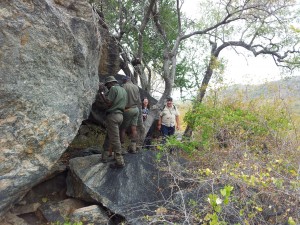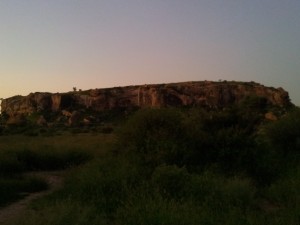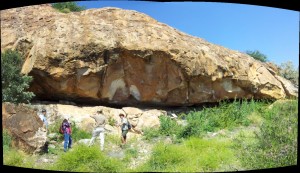Uncategorized
Postcard from South Africa #4.
June 2, 2015
by Samuel Griffiths
Wednesday 6th May.
Today we make the long drive from the border down to the south of Kruger and sadly neither Clare nor I are able to share in the driving so it is all on poor Johan, but he is very laid back about it all. As you’ll expect from me by now, the prospect of a long drive across South Africa is something I am looking forward to.
But first a real treat. A bush walk with Brigitta who showed us Koaxa’s Shelter yesterday. Its early morning and before breakfast but the bush is already alive with sounds and movement, hopefully nothing that’s planning on making us breakfast. The Mopane Bush Lodge takes its name from the mopane trees with their distinctive double winged leaves. They are everywhere and our walk is along narrow game trails. Brigitta cautions us to silence as there are leopard in the area, and Johan adds we should watch out for water buffalo too. Johan has a very healthy respect for these dangerous critters. Whenever I am out in the bush I can’t help thinking about hominins. With enclosing mopane all around us, and rustlings in the undergrowth, it reminds me of just how dangerous a life our earliest ancestors led.
Then its breakfast, and the long drive south. For me this is a day of pure pleasure. Effectively we parallel the western side of Kruger Park. Kruger is huge, 360 km long. As we travel south the view through windscreen is increasingly dominated by the Drakensberg Mountains. We pass the entrance to Blyde River Canyon, a breathtakingly spectacular gorge, a favourite of mine from the old days. This section is known as the Drakensberg escarpment, separating Kruger and the Lowveld, from the Highveld and central plateau to the west. It is amazing.
We arrive at the Malelane gate in southern Kruger in the dark and Johan has a meal and a well-deserved early night, as does Clare. I opt for a well-deserved G&T and the wi-fi, on the balcony which overlooks the river. In the darkness beyond is Kruger. I can’t help thinking about how hominins would have fared at night out there. My old friend Rob Hosfield has been on about this for a while, and listening to the night sounds across the river I think he is on to something.
In retrospect checking e-mail was a mistake.
Thursday 7th May.

‘From left to right, Rasta, Peter, Clare and Johan standing in front of the art at the site we called Peter’s Koppie’
An early start and we are heading through Kruger for Berg-en-Dal camp. In Afrikaans this means mountains and dales. It’s a fitting name for this part of the park. My earlier trips to Kruger were in the middle sections of the park which are much flatter. We meet our two guides Rasta and Peter, and we are off hunting for rock art sites. The morning is taken up with a visit to three of them.
This is real adventure stuff as we leave the vehicles and head off into the bush on foot with Peter in front and Rasta bringing up the rear, rifles loaded and ready. I ask the two of them if the places we visit have names, but they shake their heads. We call them Rasta’s Shelter, Peter’s Koppie, and Round-the-Corner rock, though I presume the rock art specialists who will have studied these sites have other names for them. There is a clear difference between these sites and Koaxa’s Shelter up north. To start with they are much more exposed to the elements and the images have suffered more. They are paler and the paintings more difficult to see. Peter and Rasta who haven’t visited these sites for a few years shake their heads sadly. The images have deteriorated a lot since they were last here. ‘Gone soon.’ says Rasta who really cares about these sites. They are an interesting contrast to Koaxa’s Shelter and important if for no other reason than they show the range and diversity of the art, as well as the problems faced in conserving it.
Peter hands out biltong and we trek back. At one point Peter makes the stop sign. We all freeze, and I just know Johan is thinking buffalo. He’s got me at it too. False alarm. A bit further on and the guys are excited about some prints – possibly cheetah – they haven’t been seen this far south in the park for a while. Again I am thinking of hominins moving through these landscapes while everything out there is bigger fiercer, stronger, and has bigger teeth. It’s a wonder we actually made it!
The afternoon is taken up with a game drive. We see plenty of elephant, buffalo and giraffe and a nervous family of warthogs. A rhino comes close to the van but we stay quiet and he wanders off. Those poor hominins.
It’s been another memorable day and the game drive was just excellent. I’ll never forget walking through the bush though, that was real Africa too. Another quiet evening on the veranda with a G&T, smoking my e-pipe. This time I wise up, I leave the wi-fi alone.
Friday 8th May
Today is our last day in South Africa, and both Clare and I are feeling rather sad about leaving. It has been a magical trip. We drive up the N4 leaving the Lowveld and climbing the escarpment at Ondervalle where Paul Kruger had his house in the last days of the Boer war – again Johan fills the landscape with stories and history. Were back on the Highveld and heading for Joburg.
Our last stop is the University of the Witwatersrand and the new (well new since my day) Evolutionary Studies Institute. Wow. Dr Bernard Zipfel gives us a tour and we get to see the new study centre with its facilities for researchers to come and study A. sediba, Littlefoot and the Taung child, and so many other of the famous fossils that have made South Africa such an important place for the human story. The museum attached is just fantastic. But beware, there is something lurking in wait here that’s far more dangerous than Johan’s buffalo – the bookshop. Boy did the bank account take a beating in that particular hominin trap.
I also get to see my old friend Professor Kathy Kuman though sadly there is too little time to talk with her about her work and what her students are up to.
Then it’s the airport and sadly goodbye to Johan.
Clare and I have many happy memories to take away, new friends made and old ones revisited. I have seen more of a country I passionately love and learned more about some of the best archaeology in the world.
Really, I wish you all had been here to share it.
Mac
Postcard from South Africa #3
May 27, 2015
by Samuel Griffiths
Tuesday 5th May.
We were supposed to have an early start this morning so we could make good time as we head north for the border – guess who blew it! Yup yours truly set the alarm wrong. A timely call from Clare who couldn’t quite hold back the giggling got me out of bed and off to breakfast in a hurry.
Johan bundled me and my stuff into the bus and off we went. Once again the drive was an instruction as Johan filled in all the gaps in the landscape with stories and titbits of local history. I don’t know how many times I have said this, but the only way to get a real handle on South Africa as a country is to spend time driving around. If nothing else you get to appreciate its size and how varied its landscapes really are. For me this was one more ambition ticked off the bucket list. Long ago I’d driven south west from Joburg to Capetown on the N1 highway and always planned to do the opposite run, northeast from Joburg to the border. Yesterday we’d come up to Mokopane from Joburg on the N1, and now we were on the same road heading for Musina and Mapungubwe. Tick, and job done.
Once through the highlands on whose southern slopes Mokopane/Makapan is located, we are on another flat plain until we hit Louis Trichartd and the last mountains before the basin of the Limpopo. The mopane tree blankets the landscape here, though as we approached the area of Mapungubwe the view through the windows was dominated by long parallel ridges of rock formations which I guess are volcanic dykes. We arrive about mid-morning, and it is another treat for me. My first ever South African rock art experience.
Our guides are Armand and Brigitta from the Mopane Bush Lodge and we take a short walk through the bush to Koaxa’s shelter. Wow!! No amount of brilliant photography or clever word-smithing can ever do these places justice. It is some of the most vivid and emotive archaeology I have ever experienced. Might be heresy for some, but I found it more moving that the cave art in Europe that I have seen. Somehow the connection to the painters seems more real here, perhaps because of the open air location. To view the art you have to lie on the same rock the artists used to paint their images. It connects you straight away. Many of these paintings may have been shamanistic, so the rock face would have been a porous membrane between our world and another. It is somehow easier to imagine the artists lying on their backs and transcribing their experiences and beliefs on to the rock face. There is something more shadowy, almost murky about European cave art.
All too soon we have to leave this beautiful spot. I scored a personal triumph here – a beautiful discoidal core on a rock surface on the way to the shelter. Like an idiot I forgot to photograph it.
After lunch it was off to the Mapungubwe interpretation centre. It is an impressive modern architectural interpretation of the traditional beehive hut-structure and contains a replica (I assume) of the famous golden rhino discovered at the site. Since we had a bit of time on our hands we took a quick drive to a local viewing point. Here the Shashe river meets the Limpopo – the border of Botswana, Zimbabwe and South Africa, but not a fence or border control in sight. It is part of the great trans-border park situated here, to allow animals to range freely and migrate across their traditional territories. The view is amazing – real Africa.
Toward the end of the day Clare, Johan and I join a cheerful tourist group on one of the only three visits allowed to the Mapungubwe site a day. Mapungubwe is one of the glories of southern African archaeology and a jewel in the crown of world civilization. It is not as well-known as Great Zimbabwe, yet it represents the emergence of a large complex state in the South African middle Iron Age (from say 900 to about 1350 AD). Mapungubwe itself did not really come into its own until well within this period (c. 1250 AD) when chiefs moved their residences onto the hill top and commoners were confined to the area below and surrounding the hill. Some archaeologists believe this is the emergence of a social organisation based on class-distinctions, the roots of what later emerges in Great Zimbabwe.
The location seems to be a huge bowl set into the side of the valley as it sweeps down to the Shashe-Limpopo. Within the basin are plateaux, one of which is the Mapungubwe hill itself, another is K2 the focus of an earlier phase of extensive social influence in the region. Other plateaux were occupied at the same time as Mapungubwe hill and were either sacred sites or were for cattle, one of the sources of wealth and power in this society. At sunset it’s a very atmospheric place. The sun goes down over Botswana, and then there is that soft half-light of the African dusk when the bush starts to wake up. Our guide armed with a rifle, takes us back to the vehicle. He has a special link with this place, it was his grandfather and great grandfather who first showed the Europeans where the site was – though his great grandfather refused to actually accompany the party in case they disturbed the spirits that still live there – sensible man.
It is easy to see why this is still a special place, and so richly deserving of its World Heritage status. The spirits may well have been appeased a little when, more than ten years ago now, human remains from archaeological investigations were ceremonially reburied on the site in the presence of sangomas who are the traditional healers and diviners of southern Africa.
What a day!
As ever, wishing you were all here.
Mac



